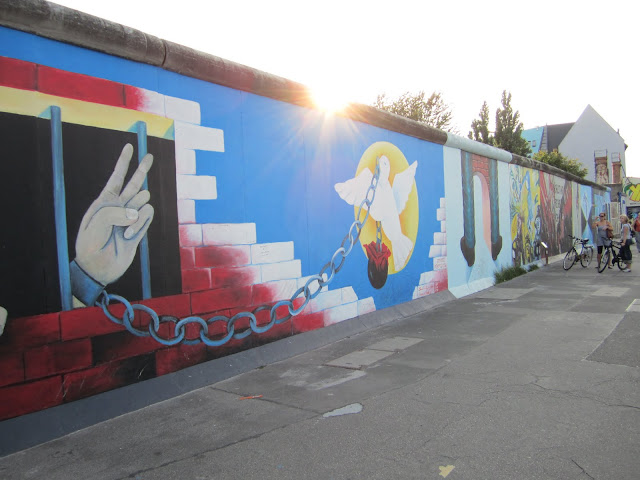The Reichstag has now been rebuilt with an amazing glass semisphere on the roof which visitors can walk in, after crossing through airport-like security... You can also see down into the German Parliament, the Bundestag (yup they still use the building today).
From the sphere we were treated to nice view of Berlin with an audio tour. After, we walked to the Brandenburg Gate.
Napoleon stole the Quadriga (the horses) on top, in the early 1800's but then surrendered it 8 years later, Napoleon was so silly. The gate was also almost destroyed during WWII, and as you can see in the patchy colored columns, was restored later (as recently as 2000).
The next day, as we wandered to our next sight-seeing adventure, I really began to imagine what living in the divided city must have been like. In the US we always hear of The Wall, but I never really got that good of idea what was going on, even after to a 10th grade history project on it. Maybe it's because it was before my time, but coming here has really painted a picture: This day's activity was to see the East Side Gallery, a 1.3k long section of the wall turned into an out door art gallery.
This wall stretched all the way around west Berlin to prevent people from fleeing from East Germany. People would escape to west Berlin and from there had access to West Germany, and western Europe, so the East Bloc erected the wall. This is from the east side, so during it's time separating the city there was no art, but instead more barbed-wire fences, watch towers, and in some spots electric fence. Also the infamous death strip, just a no mans land for escapees between the fences and wall. 136 people died at the wall in the 28 years. Berlin does a really good job at remembering their whole past, with memorials and art pieces all around the city, it's amazing how quick you absorb the history.
Well that was a photofunfilled blog, more of the Viaje aspect I guess, next one I'll put more tidbits on Lengua.
Napoleon stole the Quadriga (the horses) on top, in the early 1800's but then surrendered it 8 years later, Napoleon was so silly. The gate was also almost destroyed during WWII, and as you can see in the patchy colored columns, was restored later (as recently as 2000).
The next day, as we wandered to our next sight-seeing adventure, I really began to imagine what living in the divided city must have been like. In the US we always hear of The Wall, but I never really got that good of idea what was going on, even after to a 10th grade history project on it. Maybe it's because it was before my time, but coming here has really painted a picture: This day's activity was to see the East Side Gallery, a 1.3k long section of the wall turned into an out door art gallery.
This wall stretched all the way around west Berlin to prevent people from fleeing from East Germany. People would escape to west Berlin and from there had access to West Germany, and western Europe, so the East Bloc erected the wall. This is from the east side, so during it's time separating the city there was no art, but instead more barbed-wire fences, watch towers, and in some spots electric fence. Also the infamous death strip, just a no mans land for escapees between the fences and wall. 136 people died at the wall in the 28 years. Berlin does a really good job at remembering their whole past, with memorials and art pieces all around the city, it's amazing how quick you absorb the history.
Well that was a photofunfilled blog, more of the Viaje aspect I guess, next one I'll put more tidbits on Lengua.




No comments:
Post a Comment